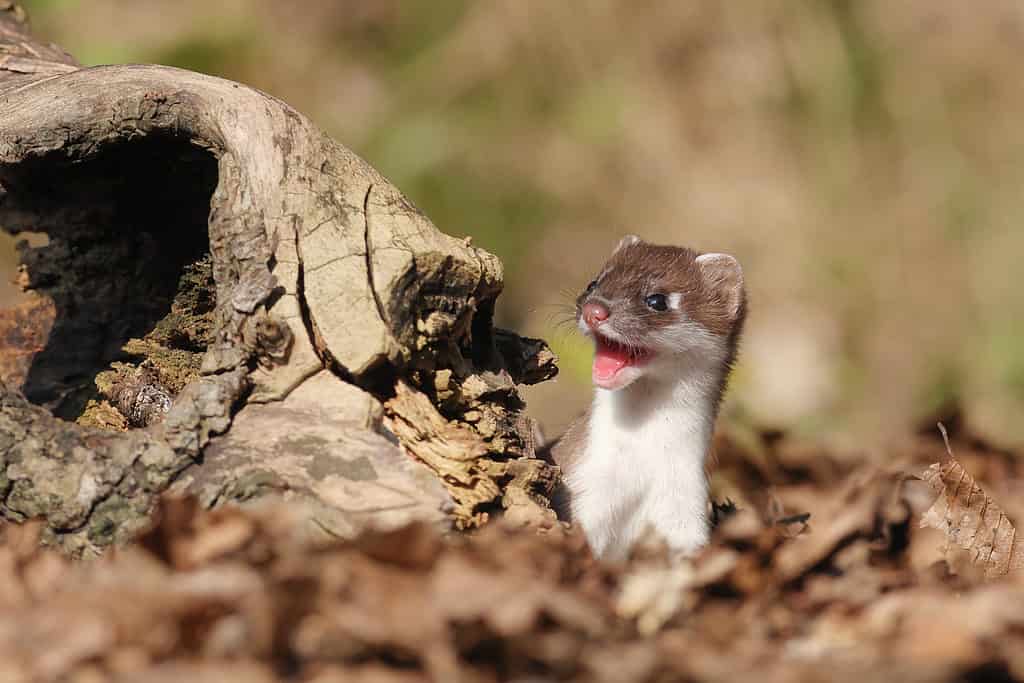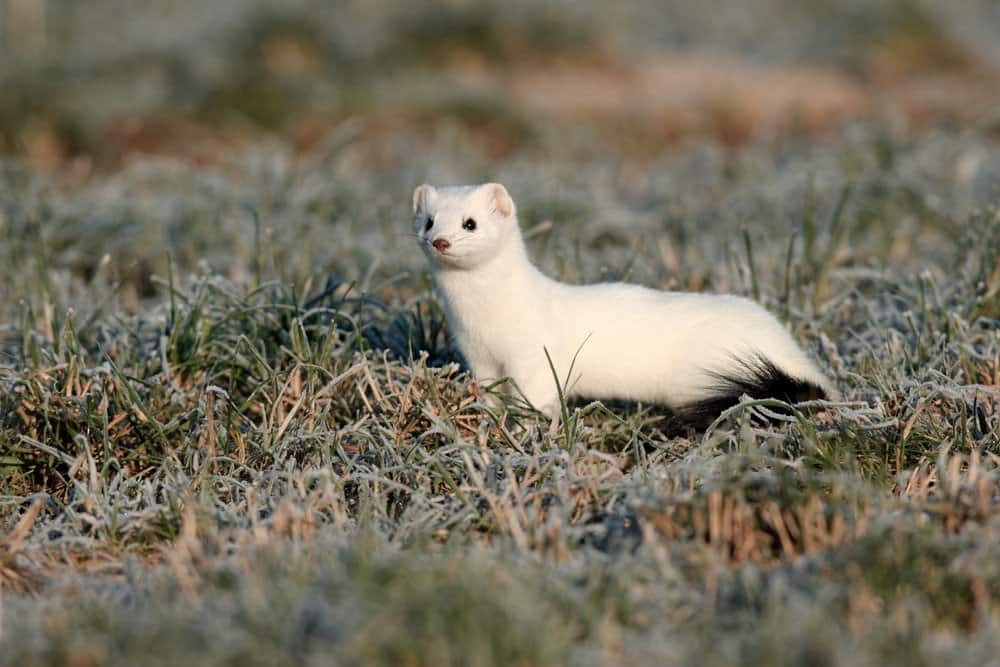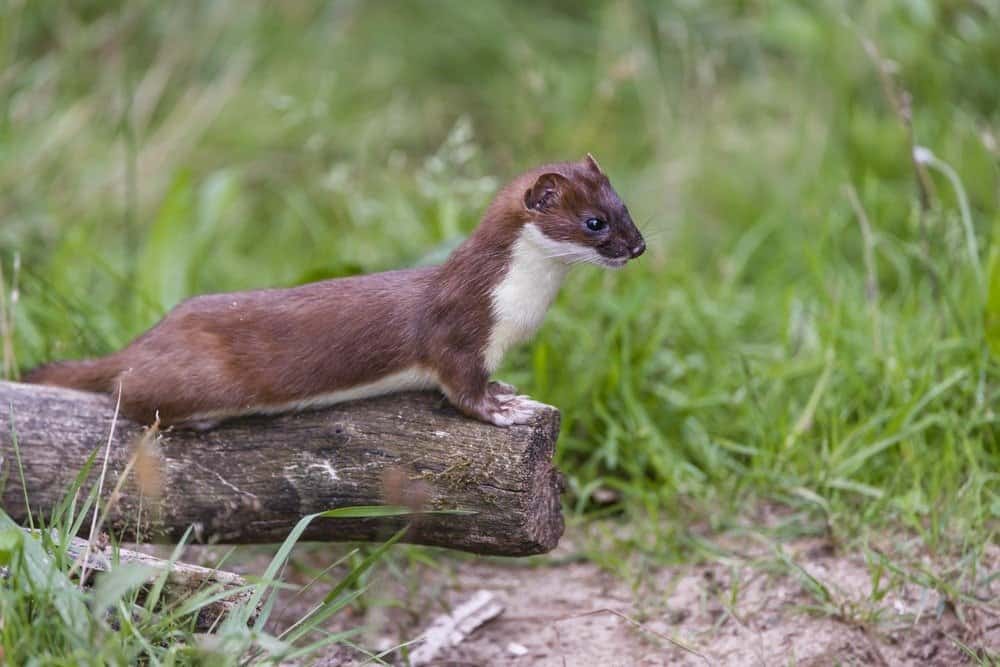Is keeping a stoat as a pet a good idea? Is it legal? Stoats are wild animals, and in most places, it is illegal to keep them as pets. Stoats are wild and wily critters made up of equal parts adorable antics and untamed instincts. While they appear cute and cuddly on the surface, stoats are carnivorous animals that would rather eat your other pets than play with them. So, turning them into household companions is a wild idea best left in the realm of imagination. Continue reading to discover more about these delightful creatures and the reasons they don’t make good pets.

Stoats are aggressive and ambitious hunters.
©Petr Muckstein/Shutterstock.com
What is a Stoat?
A stoat (Mustela ermine), also known as ermine, is a small carnivorous mammal belonging to the Mustelidae family, which includes weasels, ferrets, and otters. Forests, grasslands, and tundra are the stoats’ principal habitats. They are native to Eurasia and North America.
Stoats have a slender, elongated body, short legs, and a long tail. Their fur is usually brown with a white belly. In colder climates, their coat turns white in winter, except for their tail, which remains black. This color change provides them with camouflage in snowy environments.
Known for their speed, agility, and voracious hunting behavior, stoats primarily feed on small mammals, birds, eggs, and insects. Stoats are skilled predators, capable of taking down prey that is larger than they are. They are playful and curious, often engaging in activities like chasing their tails or performing acrobatic maneuvers. They are adaptable animals and can adjust their diet and behavior based on the available resources. Stoats are solitary creatures whose only social behavior is related to mating. Except for breeding season, stoats are territorial creatures who live alone.

In colder climates, a stoat’s coat turns white in winter, except for their tail, which remains black.
©Frank Fichtmueller/Shutterstock.com
Is Owning a Stoat a Good Idea?
Keeping a stoat as a pet is impractical and potentially harmful to both you and the stoat. It’s essential to prioritize the well-being of wild animals and respect the legal and ethical considerations associated with their care. There are several reasons why having a stoat as a pet is not a good idea. As noted earlier, it is illegal to keep them in many places, including most U.S. States. Legalities notwithstanding, stoats are not programmed to make good pets.
Stoats are wild animals with strong predatory instincts. Their natural behaviors include hunting, climbing, and exploring, which are challenging to replicate and accommodate in a domestic setting. With no outlet for their energy, stoats tend to be destructive. They may chew on furniture, electrical cords, and other household items. Their inquisitive nature can result in damage to your prized possessions. Stoats require ample space to roam and engage in natural behaviors. They are active and agile animals that need mental and physical stimulation. The confinement of a typical home does not provide the necessary space necessary for a stoat’s well-being.

Stoats are wild animals with strong predatory instincts. This poses a threat to other household pets.
©Bildagentur Zoonar GmbH/Shutterstock.com
Is It Difficult to Care for a Stoat?
Stoats have specific dietary requirements that are challenging to meet. They are carnivores and require a diet that includes a variety of fresh, raw meat. Meeting their nutritional needs can be complex and may not align with typical pet food options.
Stoats are crepuscular or nocturnal, meaning they are most active during dawn and dusk or at night. This is incompatible with the diurnal lifestyle of most humans. Stoats may be noisy or disruptive during nighttime hours. And even if they were diurnal? They are not social creatures. Except during mating season and mothers with kits, stoats are loners. Chances are your stoat would have even less interest in interacting with you than the most aloof domestic short hair (housecat). So, if it’s companionship you’re seeking in a pet, the stoat is decidedly not for you.
And then there’s the smell- though it is not as intense or offensive as a skunk’s, it’s still a concern. Stoats have a musky odor. It is often described as strong and pungent. The scent is produced by musk glands located near the base of the tail. This musky odor serves various purposes in the wild, including marking territory and communicating with other stoats. During the breeding season, the musky scent of stoats becomes more pronounced as it plays a role in attracting mates. In addition to this musky odor, stoats may also emit a foul-smelling substance when threatened, which serves as a defense against predators. Their scent-marking behavior can lead to issues with territorial marking inside the home. This alone makes them less than the ideal pet.

Stoats have a musky odor that is often described as strong and pungent.
©iStock.com/MikeLane45
Is It Safe?
It’s crucial to consider the safety and well-being of all animals in the home and to avoid situations where the natural behaviors of a stoat may lead to conflicts or harm to other pets. Keeping wild animals and domestic pets in the same environment requires careful consideration and understanding of their natural behaviors and instincts. Stoats have a strong prey instinct.
This prey drive is deeply ingrained in them and is essential to their survival. When it comes to other pets, such as cats, dogs, or small rodents, the stoat’s prey instinct can pose potential challenges and risks. The mere presence of a stoat, with its natural scent and wild behaviors, can cause stress in other household pets. Your pets may feel threatened or anxious, affecting their overall well-being. So, especially if you have other pets in your home, getting a stoat is a horrible, no-good, very bad idea.
The photo featured at the top of this post is © Martin Prochazkacz/Shutterstock.com
Thank you for reading! Have some feedback for us? Contact the AZ Animals editorial team.






